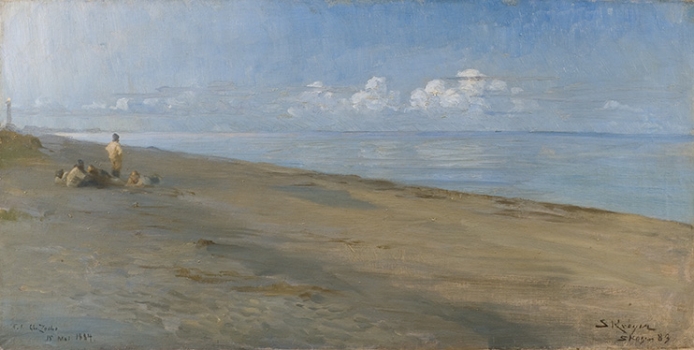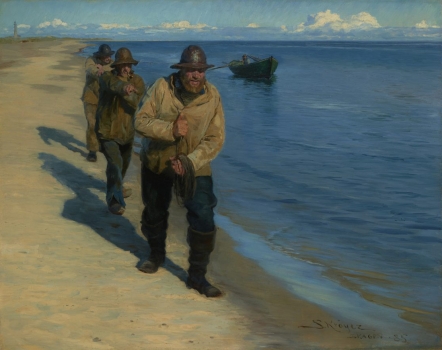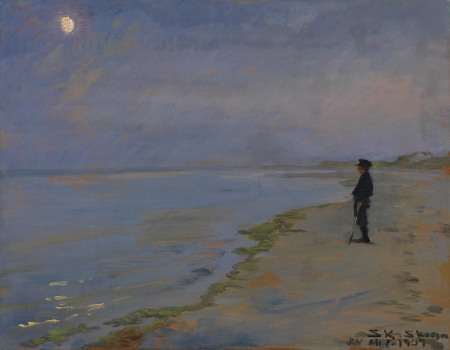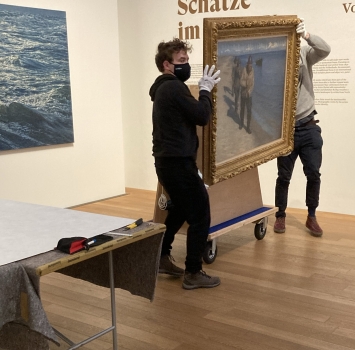The MKdW lends France the Light of the North
This year, the Musée Marmottan Monet presents, in collaboration with the Skagens Museum, the exhibition "The Blue Hour" (January 28 to July 25, 2021). This art show is the first of its kind in France as it is exclusively dedicated to the Norwegian-Danish painter Peder Severin Krøyer (1851-1909). At the Museum Kunst der Westküste, we are very pleased to have the opportunity to support this great project with three paintings from our high-caliber collection. We are particularly proud that, in addition to "Fishermen on the Beach of Skagen. Mild Summer Evening" (1883) and "Three Fishermen Hauling a Boat" (1885), we were also able to contribute Krøyer's outstanding painting "The Blue Hour" (1907) to the exhibition of the eponymous title.

Peder Severin Krøyer, Fishermen on the Beach of Skagen. Mild Summer Evening, 1883, Museum Kunst der Westküste

Peder Severin Krøyer, Three Fishermen Hauling a Boat, 1885, Museum Kunst der Westküste, photo: Ehlert

Peder Severin Krøyer, The Blue Hour, 1907, Museum Kunst der Westküste, photo: Kunde
The picture shows a man in black clothes standing alone on the seashore. His gaze averted from the viewer; he seems to look at the horizon. The sky and the coast occupy the canvas in equal parts. From the lower-left half of the painting, the seashore meanders diagonally into the distance, forming a dividing line between the sandy beach and the calm sea. The actual motif of this seascape, however, is neither the person depicted nor the landscape but the blue twilight that occupies the entire pictorial space. Sea, sky, and yellow-orange beach seem to flow into each other. Contours, such as those of the dunes in the background, dissolve. Only the pale yellow moon, which looks down on the lonely man, stands out against the dreamy blue of the landscape.
The atmospheric semi-darkness that Krøyer depicted in this melancholic, poetic painting is colloquially known as the "blue hour." This phenomenon occurs during the morning and evening twilight when the sun is between 4 and 8 degrees below the horizon. The latitude, therefore, plays a significant role in the duration of the blue hour. For Central Europe, the more northerly you are, the longer the time of this lyrical twilight lasts. Since Skagen is located in the far north of Denmark and is almost entirely surrounded by the sea, one can observe a particularly intense expression of these special light conditions there.
Krøyer probably first experienced the atmospheric transition from day to night in Skagen in the summer of 1882, when he visited the small fishing village. By this time, he was already a well-known artist. He had made a name for himself in Paris, among other places, where some of his works in the so-called Salon, the official exhibition of the Académie des Beaux-Arts, had attracted attention through excellent reviews. As a painter of international stature, Krøyer became an important member of the Skagen artists' colony. It was especially his depictions of the blue hour that contributed to the development of an expression of Plein air painting - characteristic of the Scandinavian countries.

Transport of the loans to the Musée Marmottan Monet, Photo: Maibaum, MKdW
The Museum Kunst der Westküste, however, not only presents the light of the north to the French public in the form of Krøyer's poetic visual worlds. In a way, we sent the Föhr climate on a journey as well. When transporting valuable works of art, there are incredibly high safety precautions. Not only is the vehicle air-conditioned, the transport company even builds custom-made climate boxes for the traveling artworks. In these containers, the once assumed room climate remains constant over a longer period of time. This is important because canvases expand or contract too quickly under temperature fluctuations, which can lead to cracks or even paint peeling. The three paintings from the collection of the Museum Kunst der Westküste, therefore first had to adapt from the coastal climate of Föhr to the big city climate of Paris before they were unpacked at the Musée Marmottan Monet.

Exhibition: L'HEURE BLEUE DE PEDER SEVERIN KRØYER, Musée Marmottan Monet, photo: Christian Baraja SLB
The MKdW team wishes the visitors of the exhibition "The Blue Hour" much pleasure in experiencing Peder Severin Krøyer's atmospheric snapshots of the light and living conditions in Skagen!
If you can't make it to Paris but still want to experience the magical moments of the blue hour in pictures or live, you should definitely plan a visit to Föhr. In June, the sky on the North Sea island is bathed, weather permitting, up to 57 minutes a day in an atmospheric blue.
You can also look forward to our monographic exhibition “Anna Ancher – Sun. Light. Skagen“, which, due to the pandemic, will not start in September 2021 but in March 2022. In this show, the Museum Kunst der Westküste once again creates an opportunity for special bright spots from the north of Denmark - be there.
You are welcome to support the exhibition catalog for the Anna Ancher exhibition, which is currently being prepared. We would be very happy about your donation. The show, which is very costly due to transportation costs from Skagen, will present over 80 works by Anna Ancher.
Dr. Sophie Dietrich, Research Assistant, Museum Kunst der Westküste.
L'HEURE BLEUE DE PEDER SEVERIN KRØYER
THE BLUE HOUR OF PEDER SEVERIN KRØYER
28.1. - 25.7.2021
Musée Marmottan Monet
Vorübergehend geschlossen
2, rue Louis Boilly- 75016 PARIS
